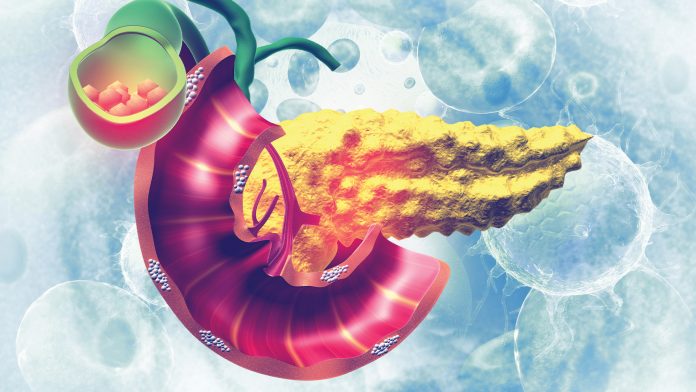
JDRF UK chief executive Karen Addington charts progress towards the artificial pancreas, a potentially life-changing technology for people with type 1 diabetes.
Diabetes treatments have come a very long way over the last 15 years, including considerable advances in medical technology. There are now pumps that can deliver insulin automatically as well as sensors that can give minute-to-minute accounts of how blood glucose levels are changing in the body. And while other technologies exist that have tremendous benefits for those living with type 1 diabetes, it is the artificial pancreas – also known as the closed-loop system – that has the potential to take away such a large amount of the blood glucose management that someone with the condition has to endure.
What we’re up against
With type 1 diabetes, being able to manage changing blood glucose levels and prevent them from going too high (hyperglycaemia) or too low (hypoglycaemia) is a relentless challenge.
This is because the beta cells which release insulin to keep blood glucose levels stable have been destroyed by the immune system, and so glucose levels must be continually monitored and adjusted manually.
It is not an understatement to say it is a 24-hour a day battle to try and keep blood glucose levels within a target range, in order to prevent the risk of serious complications which can otherwise occur long term.
It sounds simple, but the human body often defies even the most vigilant efforts to keep blood glucose levels normal. And no day is ever the same – so while you can try really hard to repeat what you did on a good day, it very often won’t work a second time.
The artificial pancreas: the holy grail of diabetes research?
In our mission to help people with type 1 diabetes lead better, safer, healthier lives until we ultimately find the cure, JDRF funds research into the development of new treatments for type 1 diabetes.
With the artificial pancreas system, which JDRF began funding early as part of its hypoglycaemia prevention efforts in 2006, blood glucose levels are tracked with a continuous glucose monitor (CGM). A computer algorithm takes the live data from the CGM and works out whether glucose levels are too high, too low, or just right, and then tells an insulin pump what is needed to keep glucose levels on track.
Exactly one decade later, the first-generation artificial pancreas system became commercially available in the United States. The Medtronic MiniMed 670G, the world’s first self-adjusting insulin pump system which automates and personalises the delivery of background (basal) insulin 24 hours a day, is due for commercial release in the UK in 2019.
And manufacturers of the Omnipod Insulin Management System have recently announced successful results in early clinical trials of its artificial pancreas system.
However, even though both these systems can manage background insulin levels automatically, user input is still required to manage mealtime peaks in blood glucose levels that come after eating carbohydrate.
This means someone with type 1 diabetes still has to work out how much bolus insulin they need in advance of what they eat.
Therefore, these devices cannot take the place of a person with type 1 having to decide on the right thing to do for themselves. For that to be the case, the gap between the process of eating and administering the required insulin needs to be closed.
Spotlight on the University of Cambridge
Otherwise known as ‘closed-loop’, this is when the right amount of insulin is automatically provided at the right time – including mealtimes.
Professor Roman Hovorka of the University of Cambridge is developing a closed-loop artificial pancreas with research funded by JDRF and the National Institute for Health Research (NIHR) at the NIHR Cambridge Biomedical Research Centre.
His closed-loop artificial pancreas will be an open protocol system so that any insulin pump and CGM can communicate with the algorithm, regardless of the manufacturer.
It is now going through advanced human trials after being found to be better at helping people with type 1 diabetes manage their blood glucose levels by keeping them in range 65% of the time, compared with 54% of the time without the technology.
New insulins wanted
Hovorka is currently perfecting the algorithm that will enable the CGM and insulin pump to take over the delivery of insulin throughout the day as well as night. However, this system still requires extra rapid-acting insulin doses at meal times.
This is because the artificial pancreas and its three pieces of technology are just the supporting bands for the main act – insulin. At the moment, the manmade insulins available are not quick enough to counteract the increase in glucose in the blood after eating carbohydrate.
New insulins are needed to fully close the loop in artificial pancreas systems and remove the entire burden of daily care, including the need to carb count and calculate the required amount of bolus insulin.
JDRF partnered with Cambridge-based pharmaceutical company Arecor in 2016 and clinical trials to develop new, rapid-acting, ultra-concentrated insulin began in 2018.
And a team at McGill University in Montreal, Canada is currently testing whether delivering the hormone pramlintide alongside insulin can improve glucose management after meals. Pramlintide is a manmade version of the hormone amylin, which the pancreas usually produces after meals to help manage glucose levels. People living with type 1 diabetes do not have normal amylin release, and so this dual-hormone artificial pancreas system could change that.
For now, the closest to an artificial pancreas currently available remains the Medtronic 670G ‘hybrid’ closed-loop system.
DIY closed-looping
And for those that didn’t want to have to wait for its arrival, there is the option to build your own.
These tech-savvy people, known as the #wearenotwaiting DIY community, are able to access free, open source technology which provides them with the means to create their own ways of automating insulin delivery.
This process, known as ‘DIY closed-looping’, is on the rise and enabling more and more patients to become experts at managing their condition. However, they do this at their own risk as healthcare professionals in the UK do not have the medical indemnity to support patients using devices in a way for which they were not regulated.
Beyond the artificial pancreas
While progress towards the artificial pancreas is something to celebrate, JDRF will continue campaigning until this life-changing type 1 diabetes technology is made available to everyone with the condition, regardless of where they live.
Over the same decade as the development of the artificial pancreas, JDRF has been investing in research that has the potential to stop the immune system from destroying the cells that make insulin in the first place.
A large part of this research is about understanding more about beta cells – how they grow, how they stay healthy and how new ones can be given to people with type 1.
For example, our regeneration research is focused on finding ways to grow, or encourage the body to grow, brand new beta cells in order to replace those destroyed by the immune system, while encapsulation research looks at ways to implant insulin-producing cells in the body while protecting them from the immune system.
But if people with the condition were given new beta cells, their immune system would still be primed to destroy them. This process needs to be stopped in order to fully cure type 1 diabetes, and to do that we must first understand how and why the immune system goes wrong in the first place.
For this reason, JDRF, MS Society and Versus Arthritis – as well as the supporting partner the British Society for Immunology – have formed Connect Immune Research, a research collaboration looking into the common mechanisms of autoimmunity.
These diverse research areas all have one thing in common – accelerating the path to the cure so that one day we will be able to consign type 1 diabetes to the history books.
A day that will be made possible with the continued dedication of JDRF, its many partners, our charitable supporters, the research teams and the support of the diabetes community across the globe.
Karen Addington
UK Chief Executive
Type 1 Diabetes Charity JDRF
Tweet @JDRFUK
https://jdrf.org.uk/
Please note, this article will appear in issue 9 of Health Europa Quarterly, which will be available to read in April 2019.






















